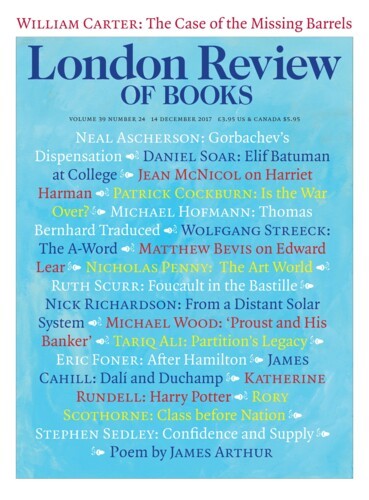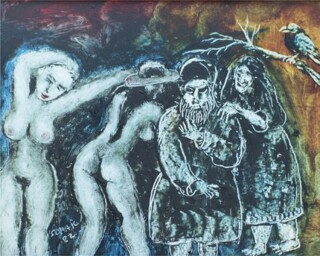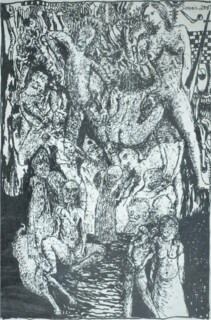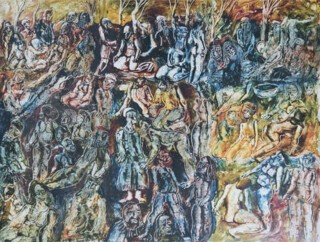In October, soon after the seventieth anniversary of Indian independence and the partition of the subcontinent, the Pakistani painter Tassaduq Sohail died in Karachi. The anniversary was celebrated with dazzling military displays: the centrepieces in both Delhi and Islamabad were nuclear missiles. Partition is history now, tales grandparents tell, but for Sohail and others who experienced it first-hand, the memories have never lost their force.
In January 2000, after forty years in Britain, Sohail decided to return to Pakistan. A week or so before he left, I got a call. He spoke, as always, in Punjabi and by common agreement we avoided using any English words, a common practice (and not just in the diaspora) that enraged him. It was a test I sometimes failed. Sohail was 17 years older than the country he sometimes called home and sometimes hell. Usually when he rang, he would recite a few lines from the Sufi poets with gaiety in his voice, and occasionally he even laughed at my attempts at Punjabi double entendres. But this time his tone was sombre.
‘I’m going back.’
I was taken aback. There had been no hint of this in recent conversations. ‘Why?’
‘To die.’
‘Why?’
‘Everyone has to. I thought it best to be close to my final destination.’
I laughed. His laugh was forced. He didn’t have too many plans or hopes. After forty years, he had no family and few real friends in Britain. The decision to return had been taken with very little consultation. Among the few people with whom he felt a sense of camaraderie were three Jewish elders in Golders Green (‘my three fathers’) who had posed for him and become friends. They look quite jolly in his depiction. He hadn’t discussed his decision with them because one of them was always thinking about moving to Israel, the other two were strongly opposed and it would have provoked a row between them. Suddenly he fell silent, then spoke in a very abrupt tone. ‘Tell me something. Be honest. Do you think any of my paintings would encourage anybody to fight back? I mean anyone. Even a single person? You, for instance?’
It was a puzzling question from someone who had never shown any interest in politics. I said as much. It turned out that he had recently returned from Berlin where he’d heard some English people (‘white people from here’, as he put it) in the Käthe Kollwitz museum say that about her work. He was equally happy for people to dislike his work or like it very much. What he hated was eliciting no response at all. That was really why he was going back. Whatever else, in Pakistan there would be a reaction. I worried that the response might be fatal. His head might be blown off. I didn’t say this because he knew it better than I did.
On a previous trip to Karachi, he had sold erotic paintings to what he described to me as ‘rich begums left alone by their husbands during the day’. They bought his paintings in secret and a few of them commissioned new work, giving detailed and ‘shameless’ instructions on what they required him to paint. ‘For the first time I realised the function of a eunuch in the harem,’ he told me. I asked for names. He declined. ‘Pity the poor eunuch caught revealing secrets.’
He’d made a fair bit of money and thought that he could always repeat the process when he got back to Karachi. I’m not sure he did. The atmosphere had changed and the combination of philistinism and piety meant that Sohail was no longer received in polite society, not even in secret. His phone calls became less frequent, then stopped altogether. The last time I had a conversation with him was more than ten years ago, after he’d read the final novel in my Islam Quintet. The painter in it was loosely based on him.
He wasn’t finding it easy in Karachi. Hell was lonely too, just like England. Too many of his friends were dead. The city had become a network of competing protection rackets. Culture was disintegrating. Nobody paid him much attention. ‘I feel a python has wrapped itself around my heart.’ Depictions of his inner life weren’t selling. Piety was so widespread that he had become very cautious: he stopped painting beards and penises. More and more animals began to appear in his work (including the odd unicorn) as well as mermaids in different shapes and sizes. Both safe. The colours became more vibrant: a lot of turquoise and sea green. It was obvious that he was painting to please. He admitted this, saying he was returning to his street artist years in London. I reminded him that was not the way he had begun. ‘We are all driven by our destinies, friend. Mine is to spend the few remaining years sinking slowly in this wasteland.’
Of all my friends and acquaintances from the subcontinent, Sohail was the most traumatised by Partition and also the least political. His imagination was haunted by the horrors of 1947. The images grew misty, but he never got over it. One result was his aversion to all religions, to which he attributed the tragedy: several million refugees and well over a million dead bodies. On this he never softened. All my attempts to explain the 1947 divide as the result of global events, how they were refracted in India and used by politicians, were greeted with a snort.
I first met him in 1987. He had managed to raise the money to fund an exhibition in a small gallery on a tiny street on the fringes of Bloomsbury. A friend rang to insist I go and see it without telling me too much about it. I’d never heard of Tassaduq Sohail, which was an added inducement. Sohail rang too and suggested he could have the gallery opened for me on a Sunday if that made it easier. It did. A short, thin, prematurely bald, middle-aged Asian man in a light-blue supermarket security guard’s uniform let me in. I suppressed a smile at the incongruity between his uniform and his stature. He switched on the awful neon lights. We were on the ground floor and I could now see that the walls were covered with miniatures painted in black ink. Each etching was crowded with strange figures, both male and female, each face agonised, almost paralysed by the brutalities being inflicted. The intensity was astonishing. What was disconcerting, as I inspected each of the sixty or seventy works in turn, was being followed by the security guard in his ghastly uniform. I was sorely tempted to ask him to wait outside, but it was raining. Just as well. It turned out he was the painter.
It was June 1947. He and his parents were leaving everything behind except for a few clothes and some heirlooms. All the Muslims in his village in the Punjab were waiting for a bus to take them to Jalandhar, from where they would be transported in larger buses and trucks to Lahore, now in Pakistan. A number of Sikh neighbours, he recalled, came to embrace them, but they didn’t hang around, not wanting to be seen by their more fanatical brethren.
In Jalandhar, Sohail ran to the first vehicle in the convoy of buses and trucks, but his parents called him back and told him to let the elderly and those with very young children on first. Instead, they got on the second bus, which was already over-full, and then they were delayed waiting for stragglers. The first bus moved off. Their convoy caught up with it thirty miles later. Every single person had been dragged out and killed. He remembered the blood, the naked bodies of women of all ages, violated before their throats were slit. Dead babies beside dead mothers. The convoy came to a halt. People rushed out screaming as they recognised friends and relations. The drivers checked to see if anybody was alive. Nobody. The convoy now moved at great speed, the drivers ignoring all attempts to stop them. There was no time for burials. A few bullets were fired at them, but they reached Lahore safely. ‘Everyone went crazy,’ Sohail muttered. ‘Each side massacred innocents. The whole of the Punjab was an inferno. We left one hell and arrived in another, but we were alive.’
His parents moved to Karachi in 1952, but he wasn’t happy there, never found a partner. He wrote a few short stories. Nothing ever worked out. Witnessing the aftermath of massacre made him extremely pessimistic, apolitical and bitter. He remained alienated on every level. Two years after the 1958 military coup in Pakistan, he left for Britain. In those days no visas were needed for Commonwealth citizens and five years of permanent residency entitled them to UK citizenship.
He got a factory job in Ealing, and shared a room with other immigrants: shift work meant that the landlord (usually a fellow South Asian) could charge four lots of rent per room per day, a very primitive accumulation of capital that led in due course to many medium-sized fortunes and a few supermarket empires. It was the first time since 1947 that he had met, eaten and conversed with Sikhs, some of whom were from Jalandhar. The work itself he hated. One thing stuck in his mind. His fellow Asians got very agitated at the reluctance of the white shop stewards of the Transport and General Workers’ Union to give them union cards. Sohail didn’t care at all.
The high point of his social life, he told me, was to save up a few shillings, visit a strip-joint in Soho and then, while the memory was strong, indulge in some fist-fucking. I was never convinced by the stories he sometimes told me (usually when others were present) stressing his virility and his conquests. He told me more than once that he preferred living on his own. The women he sometimes turned up with were for the purpose of showing off. All the ones I met were his models, who were very fond of him because no sexual favours were demanded. Two of them, at least, were sex workers. They told him their stories and he painted them with a real anger at their circumstances.
He changed jobs frequently. After the West London factory, he moved to Golders Green, rented a room and got work in a newsagent’s at the tube station. He started sketching in notebooks or on blank paper to pass the time. One day an Englishman who regularly bought the Times from him asked what he was drawing. He told him he should take up painting seriously and bought a few pages of the notebook. Soon after that he left his job, abandoned his black ink drawings and concentrated instead on pastels and acrylic and watercolours. He sold his work on the pavement outside Hyde Park. He said that the worse the painting was, the more likely it was to sell. He started putting in a few naked women and sales rocketed.
On the first floor of the Bloomsbury gallery the work was entirely different from the black ink drawings below: paintings in exuberant colours, full of humour. They were viciously satirical, with religion and its hypocritical clergy as the target. Sex had all of them in thrall. Here was a mullah walking with his wife but thinking of two naked women and watched by an all-knowing crow. Sohail regarded animals as more refined in many ways than men and they began to dominate his work. There is a watercolour of a Hindu or Buddhist monk having a wet dream, an arc of sperm rising from his penis and descending on the backside of a distant doe. It’s quite a sweet representation.
Partition had convinced him that the capacity of humans to do mischief to one another was limitless. My attempts to give him explanations for the violence were shrugged off. For a while his paintings became more and more vicious, with the penises of clergymen or the priests of ancient Egypt often depicted as oppressive weapons. I was worried someone might issue a fatwa. He was unconcerned. ‘All the humans in my work are anonymous. They have no identity. What could be the content of such a fatwa? That I’m blaspheming against a particular penis? I don’t think any mullah anywhere is going to self-identify to such an extent. And what you don’t know is that more than a few religious-minded scholars buy these paintings.’
When I asked if he’d ever had any formal training his explanation was not out of kilter with the rest of his life. ‘When I was working as a bus driver I used to go past the art school on Charing Cross Road every day. It was a busy road and slow. It was summer. On the pavement, leaning against the fence or sitting on the steps, I would see very beautiful young men and women, joking and laughing. I wondered what happened inside that building. I didn’t think they could be artists. They looked too happy. On one of my days off I went to investigate. There was a long queue. They told me they were painting nudes that day. I joined them and was given pastels and paper. I sketched a female nude in black, with two red dots as her nipples, very restrained work. A teacher standing behind me and looking over my shoulder, smiled and said: “You have a good sense of colour.” Two red dots were enough for her! She had a good sense of humour, I thought, but she encouraged me to return. For the next six months, I went once every week, probably the most valuable days in my life as an artist.’ That was the extent of his training.
I can’t think of a single well-known Muslim writer, poet or film-maker who was in favour of Partition in the decades preceding 1947. No one really believed it would happen. The demand for a Muslim nation was a bargaining counter to get the best possible deal for the country’s largest minority (between 30 and 40 per cent of the population) in a federal India. Only recently, Muslims, Hindus and Sikhs had fought together in the Indian National Army (INA) formed by Subhas Chandra Bose from Indian prisoners of war held by Germany and Japan. A year after the war, British India experienced its largest mutiny when naval ratings occupied destroyers and troop ships, refusing to surrender until leaders of the Congress and the Muslim League appealed to them to do so in the name of a ‘free India’. Here too, all three religions, including middle and low-caste Hindus, fought together, as they had ninety years earlier in the 1857 uprising. ‘Free India’ never re-employed these ‘mutineers’, though Pakistan allowed some of the Muslim participants to join its new navy.
Sohail once asked me whether Partition could have been avoided. To which my answer remains yes. Trotsky’s view that history shares commonalities with biology, and that causality works through a ‘natural selection of accidents’, is a pretty good description of what happened in India. The determining accident was the Second World War. Soon after September 1939, Gandhi visited the viceroy, Lord Linlithgow, assuring him that he and all right-minded people supported Britain, but that there was great hostility in the Congress, which he could not ignore. The British needed colonial cannon-fodder even more in this war than in the one before, and for that reason could not agree to grant India immediate independence. As a result, all the provincial Congress administrations submitted their resignation to the viceroy. Tame pro-British governments took their place.
The Muslim League leader, Mohammed Ali Jinnah, suited, booted and monocled, also went to call on the viceroy. His message was simple. The Muslim League, unlike the Congress scoundrels, was solidly behind the war effort. He wanted guarantees of minority rights (a strong federation with limited powers for the centre) or a separate state altogether. The advantage of the latter, he calmly explained to the viceroy, was that it would enable the British to retain a foothold in the subcontinent. Pakistan would be loyal. Churchill was delighted.
What a historical turnaround this was. The Muslims had been held responsible for the 1857 uprising since its titular leader was Bahadur Shah Zafar, the last of the Mughals, a mild-mannered man on an East India Company pension who lived in the Red Fort in old Delhi, where he spent his time writing poetry. His writ never extended beyond the Fort. The bulk of the fighting against the British in 1857 was actually carried out by Hindu and Muslim soldiers. It was this tradition to which Bose had appealed when creating the INA. Afterwards, many religiously unified divisions were separated to prevent a repeat performance. The Sikhs and Muslims who had remained loyal (mainly Punjabis) became the most trusted troops in imperial wars.
The favour shown by the British to the Muslim League became even more pronounced after the fall of Singapore to the Japanese in February 1942. INA units under Bose fought against the British Indian Army. For the first time ever, Gandhi lost his cool. Until now he had been playing cat and mouse with the Raj, knowing that only a negotiated settlement would enable what he considered a satisfactory transition to independence. The Japanese triumph in Singapore disoriented him. He now believed he might be forced into negotiating independence with Hideki Tojo, the Japanese prime minister, rather than Churchill and that the Japanese might install Bose as the leader of the new India. In March 1942, the British war cabinet, alerted to the danger by intelligence reports, despatched the Labour cabinet minister Stafford Cripps to plead with the Congress to return to the fold and help the war effort. ‘I have been authorised to offer you a blank cheque once the war is over,’ Cripps told Gandhi.
‘What is the point of a blank cheque,’ Gandhi asked, ‘from a bank that is obviously failing?’
A few months later, in August 1942, Congress launched the Quit India movement, demanding immediate independence. Millions took part in demonstrations: Gandhi and his colleagues had mobilised the peasantry on a scale comparable to the Chinese revolution. The British resorted to large-scale repression. There were hundreds of arrests and the independence leaders were sent back to prison. Had the Congress accepted the war cabinet’s offer, they would have been given the whole of India on a platter.
The Muslim League and the Communist Party of India grew rapidly under British patronage. Pakistan was a thank you present to the Muslim League from the British, but it was handed over only after the Congress leaders had rejected all compromises. Nehru’s obstinacy and arrogance trumped Gandhi’s more conciliatory posture: he had suggested a national government with Jinnah as prime minister only to be vetoed by Nehru and the right wing of the Congress. As late as 1946, Jinnah was prepared for compromise, but the situation was deteriorating rapidly. Anti-Muslim pogroms in Bihar resulted in thirty thousand deaths, but Nehru and Gandhi equated the massacre with a riot in Noakhali in Bengal in which fewer than fifty Hindus were killed. They refused to take Jinnah seriously, believing, wrongly, that the Muslims were tightly controlled by their religious leaders, some of the most prominent of whom were either in the Congress, like Abul Kalam Azad, or collaborated with it. The Jamaat-i-Islami, led by the formidable Maulana Maududi, opposed the very idea of Pakistan: Islam was either universal or it was nothing. The preachers of the most important seminary of orthodox Islam in Deoband also opposed Partition. But Nehru and Gandhi should have studied a bit of Muslim history. Muslims have never been united for long. They do not like tight control. India’s Muslims did not follow their religious leaders in late 1946 and 1947 but turned to Jinnah. Nehru too had an outdated view of the Muslim League. Like the Congress, it had been a party of notables before being taken over in the 1930s by liberal lawyers, journalists and mostly secular Muslim intellectuals under the leadership of Jinnah, a prickly but brilliant criminal lawyer, who was a committed constitutionalist. At that time the League was still a minority force within Indian Islam. The war and British patronage helped change that, and Hindu chauvinism did the rest.
By 1946 it was too late to stop Partition, but the complete failure of the colonial state to safeguard human lives was a sign that it had abdicated its responsibilities. Having encouraged religious divisions within the army, the colonial authorities were worried that Hindu troops would refuse to obey orders if asked, say, to fire on Hindu crowds. As a result, the army would look on while one religious group slaughtered another and the country disintegrated. And so two-thirds of India’s Muslims became part of Pakistan as the Punjab and Bengal were split off, separated from each other by a thousand miles of Indian territory. But Partition solved very little and the divisions it entrenched enabled the election of a semi-fascist government in India, where it is now open season on Muslims and other minorities. In Pakistan, Muslim slaughters Muslim: there’s nobody else left to kill.
Sohail once told me that he adored Ibsen and had seen all his plays. His favourite was Ghosts. He liked the portrayal of the severely disabled son, Oswald, a painter. Sohail underlined the passage in which Oswald wants his mother to help him die:
Oswald: You’ll have to help me now, mother.
Mrs Alving: I?
Oswald: Who better than you?
Mrs Alving: I? Your mother?
Oswald: For that very reason.
Mrs Alving: I, who gave you life!
Oswald: I never asked you for life. And what kind of life have you given me? I don’t want it! You take it back!
Send Letters To:
The Editor
London Review of Books,
28 Little Russell Street
London, WC1A 2HN
letters@lrb.co.uk
Please include name, address, and a telephone number.




